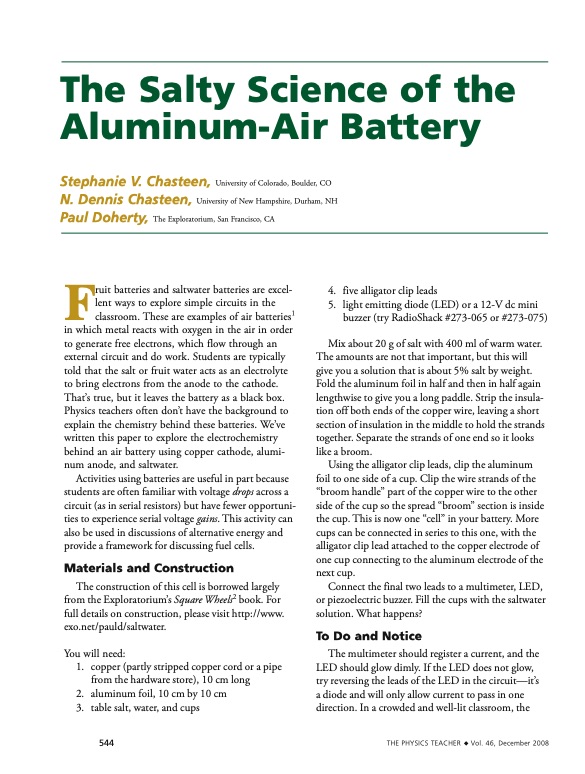
PDF Publication Title:
Text from PDF Page: 001
The Salty Science of the Aluminum-Air Battery Stephanie V. Chasteen, University of Colorado, Boulder, CO N. Dennis Chasteen, University of New Hampshire, Durham, NH Paul Doherty, The Exploratorium, San Francisco, CA Fruit batteries and saltwater batteries are excel- lent ways to explore simple circuits in the 1 classroom. These are examples of air batteries in which metal reacts with oxygen in the air in order to generate free electrons, which flow through an external circuit and do work. Students are typically told that the salt or fruit water acts as an electrolyte to bring electrons from the anode to the cathode. That’s true, but it leaves the battery as a black box. Physics teachers often don’t have the background to explain the chemistry behind these batteries. We’ve written this paper to explore the electrochemistry behind an air battery using copper cathode, alumi- num anode, and saltwater. Activities using batteries are useful in part because students are often familiar with voltage drops across a circuit (as in serial resistors) but have fewer opportuni- ties to experience serial voltage gains. This activity can also be used in discussions of alternative energy and provide a framework for discussing fuel cells. Materials and Construction The construction of this cell is borrowed largely from the Exploratorium’s Square Wheels2 book. For full details on construction, please visit http://www. exo.net/pauld/saltwater. You will need: 1. copper(partlystrippedcoppercordorapipe from the hardware store), 10 cm long 2. aluminumfoil,10cmby10cm 3. tablesalt,water,andcups 4. fivealligatorclipleads 5. lightemittingdiode(LED)ora12-Vdcmini buzzer (try RadioShack #273-065 or #273-075) Mix about 20 g of salt with 400 ml of warm water. The amounts are not that important, but this will give you a solution that is about 5% salt by weight. Fold the aluminum foil in half and then in half again lengthwise to give you a long paddle. Strip the insula- tion off both ends of the copper wire, leaving a short section of insulation in the middle to hold the strands together. Separate the strands of one end so it looks like a broom. Using the alligator clip leads, clip the aluminum foil to one side of a cup. Clip the wire strands of the “broom handle” part of the copper wire to the other side of the cup so the spread “broom” section is inside the cup. This is now one “cell” in your battery. More cups can be connected in series to this one, with the alligator clip lead attached to the copper electrode of one cup connecting to the aluminum electrode of the next cup. Connect the final two leads to a multimeter, LED, or piezoelectric buzzer. Fill the cups with the saltwater solution. What happens? To Do and Notice The multimeter should register a current, and the LED should glow dimly. If the LED does not glow, try reversing the leads of the LED in the circuit—it’s a diode and will only allow current to pass in one direction. In a crowded and well-lit classroom, the 544 THE PHYSICS TEACHER � Vol. 46, December 2008PDF Image | Salty Science of the Aluminum-Air Battery

PDF Search Title:
Salty Science of the Aluminum-Air BatteryOriginal File Name Searched:
TPT_Salty_Science.pdfDIY PDF Search: Google It | Yahoo | Bing
Product and Development Focus for Salgenx
Redox Flow Battery Technology: With the advent of the new USA tax credits for producing and selling batteries ($35/kW) we are focussing on a simple flow battery using shipping containers as the modular electrolyte storage units with tax credits up to $140,000 per system. Our main focus is on the salt battery. This battery can be used for both thermal and electrical storage applications. We call it the Cogeneration Battery or Cogen Battery. One project is converting salt (brine) based water conditioners to simultaneously produce power. In addition, there are many opportunities to extract Lithium from brine (salt lakes, groundwater, and producer water).Salt water or brine are huge sources for lithium. Most of the worlds lithium is acquired from a brine source. It's even in seawater in a low concentration. Brine is also a byproduct of huge powerplants, which can now use that as an electrolyte and a huge flow battery (which allows storage at the source).We welcome any business and equipment inquiries, as well as licensing our flow battery manufacturing.| CONTACT TEL: 608-238-6001 Email: greg@salgenx.com | RSS | AMP |